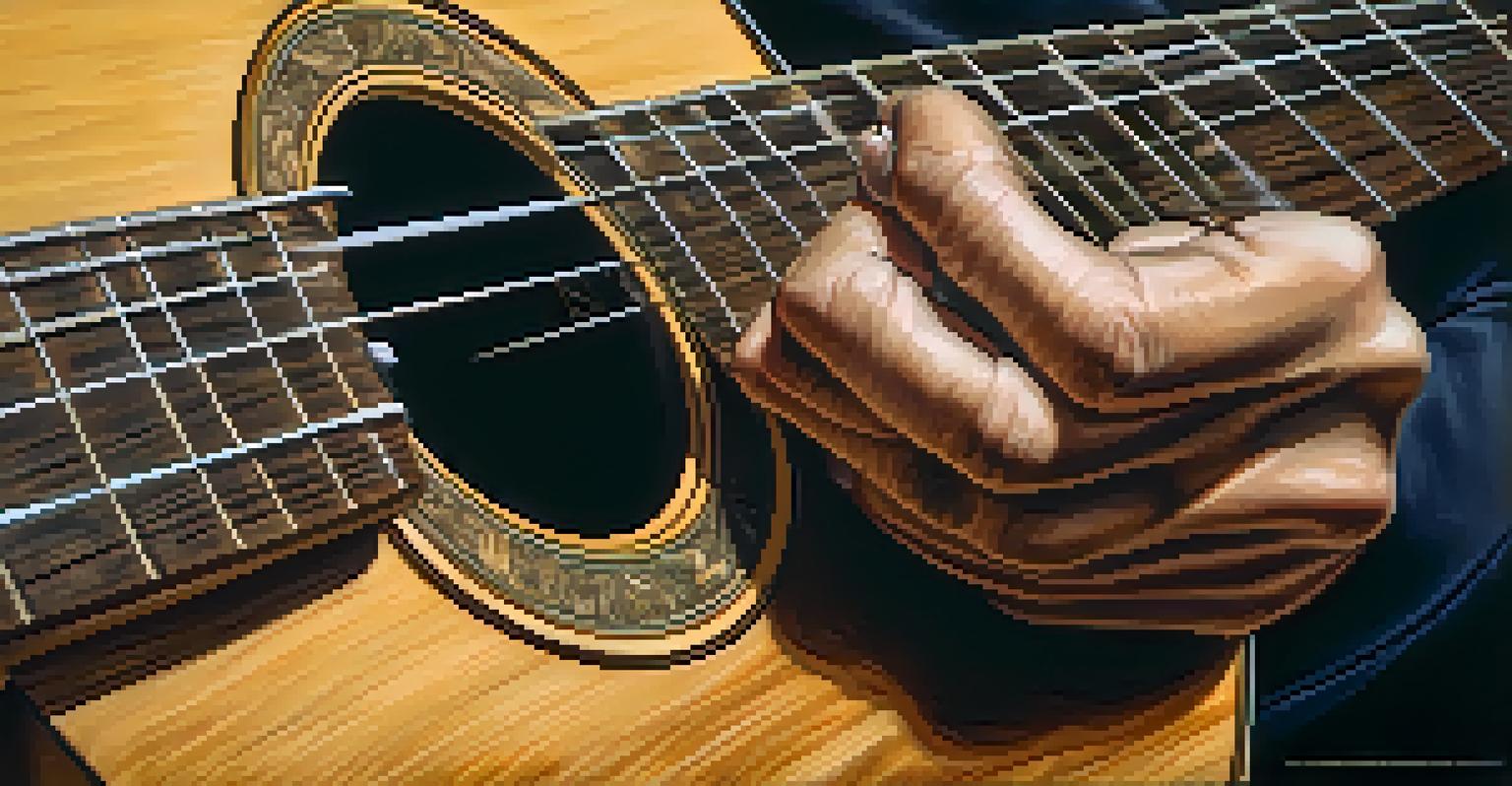Top 10 Finger Dexterity Exercises for Guitar Players

Understanding Finger Dexterity and Its Importance
Finger dexterity refers to the ability to use your fingers efficiently and skillfully, which is crucial for guitar players. It allows for smoother transitions between chords and faster note playing, ultimately improving your overall performance. Just as a pianist relies on nimble fingers to create harmonious melodies, guitarists must develop similar dexterity to master their instrument.
The more you practice, the better you become. The more you can express yourself through your instrument.
When you think about it, finger dexterity is like the foundation of a house; without it, everything else you build on top will struggle to stand. Whether you’re strumming a gentle ballad or shredding a high-energy solo, having agile fingers can make all the difference. Therefore, incorporating exercises into your practice routine can significantly enhance your playing ability.
In this article, we’ll explore ten effective exercises designed specifically to boost finger dexterity. These exercises are not only beneficial but also enjoyable, making them a vital part of your daily practice. So, let’s dive into the world of finger workouts that can transform your guitar skills!
Exercise 1: Finger Tapping Techniques
Finger tapping is a popular technique that involves using your fingers to tap notes on the fretboard, rather than plucking them with a pick. This exercise can help improve your finger strength and independence, as each finger works individually to create sound. It’s similar to how a drummer uses their hands to create rhythm; the more you practice, the more fluid your movements become.

Start by selecting a simple scale, such as the pentatonic scale. Tap each note using your fingers while keeping the other fingers steady on the fretboard. Initially, it may feel awkward, but with consistent practice, you’ll notice a marked improvement in your dexterity and speed.
Importance of Finger Dexterity
Finger dexterity is essential for guitarists, enabling smooth transitions and faster note playing for improved performance.
Incorporating finger tapping into your warm-up routine can yield tremendous benefits. As you progress, try increasing the speed of your tapping or incorporating different scales and patterns to keep it interesting. This exercise not only builds strength but also enhances your coordination.
Exercise 2: The Spider Exercise
The Spider Exercise is a classic warm-up that focuses on finger independence and coordination. By mimicking the movements of a spider, you’ll help your fingers learn to move individually and efficiently across the fretboard. Picture a spider climbing a web; the way it moves each leg independently is similar to what you’ll achieve with this exercise.
Practice does not make perfect. Only perfect practice makes perfect.
To perform the Spider Exercise, place your fingers on the first four frets of the low E string, and then use a sequence of alternating finger movements across the strings. Start slowly, ensuring that each note rings clearly before increasing your speed. This exercise not only helps with dexterity but also builds muscle memory.
The key to mastering the Spider Exercise is consistency. Incorporate it into your daily practice and challenge yourself to play it in various tempos and rhythms. Over time, you’ll notice a significant improvement in your finger agility, making it easier to tackle more complex pieces.
Exercise 3: Chromatic Scale Practice
Practicing the chromatic scale is an excellent way to enhance finger dexterity. This scale involves playing each note in succession on the fretboard, which helps develop both speed and precision. Think of it as the building blocks of your guitar skills, laying a solid foundation for more advanced techniques.
Begin by playing the chromatic scale starting from the open string up to the 12th fret, using all four fingers in succession. Focus on keeping your fingers close to the fretboard and ensuring each note is clear and resonant. As you become comfortable, challenge yourself by increasing the speed or adding variations.
Effective Finger Exercises
Incorporating targeted exercises like finger tapping and the Spider Exercise can significantly enhance finger strength and coordination.
Incorporating the chromatic scale into your routine not only improves dexterity but also enhances your understanding of the fretboard. This familiarity will prove invaluable when you start improvising or playing more intricate pieces. Make it a habit to practice this scale regularly for optimal results.
Exercise 4: Finger Stretching Drills
Finger stretching drills are essential for improving flexibility and reach, crucial elements for any guitarist. These exercises help your fingers become accustomed to wider stretches on the fretboard, which is particularly helpful for playing barre chords and complex chords. Imagine a rubber band; the more you stretch it, the more flexible it becomes.
To perform finger stretching drills, select a simple chord and then gradually stretch your fingers to reach the appropriate frets. You can also practice placing your fingers on non-adjacent frets, which helps develop reach and strength. Start slow, and as you become more comfortable, increase the complexity of the drills.
Dedicate a few minutes of your practice time to these stretching drills. Over time, you’ll notice increased flexibility and a newfound ease when tackling difficult chords. Remember, just like any athlete, building flexibility takes time and persistence.
Exercise 5: The 1-2-3-4 Exercise
The 1-2-3-4 exercise is a straightforward yet powerful technique for improving finger coordination and strength. By using each finger in sequence across the fretboard, you’ll enhance your ability to transition smoothly between notes. Think of it like a warm-up for your fingers before a big performance; it prepares them for the tasks ahead.
To perform this exercise, place your index finger on the first fret, middle finger on the second, ring finger on the third, and pinky on the fourth, on a single string. Play each note in succession and then move to the next string. This simple exercise can be done on any string and at various frets to keep things dynamic.
Role of Timing in Practice
Using a metronome during practice helps develop timing and rhythm, which are crucial for achieving precision in guitar playing.
Integrating the 1-2-3-4 exercise into your warm-up can lead to remarkable improvements in your finger agility. As you practice, try to increase your speed while maintaining clarity in each note. This exercise is a fantastic way to build a solid foundation for more intricate playing.
Exercise 6: Scale Variations and Modes
Exploring scale variations and modes can be an enjoyable way to enhance finger dexterity while also expanding your musical vocabulary. By practicing different scales, you’ll not only improve finger agility but also gain a deeper understanding of music theory. Think of it as learning different dialects; the more you know, the more expressive you can be.
Start by selecting a scale, such as the major or minor scale, and then experiment with different modes like Dorian or Mixolydian. Play each mode slowly, focusing on finger placement and clarity. Gradually increase the speed as you become more comfortable with the fingerings.

Incorporating scale variations into your practice can make it more engaging and beneficial. You'll find that as your finger dexterity improves, so will your overall musicianship. Plus, experimenting with modes can lead to exciting new sounds in your playing.
Exercise 7: Chord Progressions and Transitions
Practicing chord progressions is essential for any guitarist, and it’s also a fantastic way to enhance finger dexterity. As you move between chords, your fingers learn to adapt quickly, building muscle memory and speed. It’s much like a dance; the more you practice, the more fluid your movements become.
Start with simple progressions, such as G-C-D or A-Am-E, and focus on making smooth transitions between them. Pay attention to finger placement and try to minimize any unnecessary movement. As you gain confidence, challenge yourself with more complex progressions to further develop your skills.
Incorporating chord progressions into your daily practice can lead to significant improvements in your playing. The more you practice, the more natural these transitions will feel, allowing you to focus on expression and creativity during your performances.
Exercise 8: Using a Metronome for Timing
Using a metronome can greatly enhance your finger dexterity by helping you develop a sense of timing and rhythm. Practicing exercises with a metronome ensures that you play your notes evenly and accurately, which is essential for any musician. Think of it as your personal drummer, keeping you in sync as you explore different techniques.
Start at a slow tempo and gradually increase the speed as you become more comfortable with the exercises. This approach allows you to focus on accuracy without feeling rushed. As you gain confidence, challenge yourself by playing along with the metronome at faster tempos.
Incorporating a metronome into your practice routine can yield tremendous benefits. Not only will your finger dexterity improve, but you’ll also develop a stronger sense of timing, which is crucial for playing with other musicians. The combination of precision and rhythm can elevate your guitar playing to new heights.